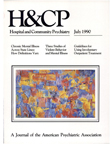Precipitants of Violence in a Psychiatric Inpatient Setting
Abstract
Data gathered from the medical record and in interviews with staff and patients in an inpatient psychiatric setting at a Veterans Affairs medical center were used to examine events preceding 73 episodes in which patients were placed in four-point restraints. The behaviors leading to restraint included physical aggression, verbal threats, and threats with an object as a weapon. These behaviors were more likely to relate to external situations than to the patient's internal psychiatric symptoms. Staff were most frequently the target of patients' aggression, and patients were more likely to view the events leading to restraint as conflict with staff. No differences in the subsequent number of restraint episodes or hours in restraints were found between patients with positive and negative responses to the index restraint episode.
Access content
To read the fulltext, please use one of the options below to sign in or purchase access.- Personal login
- Institutional Login
- Sign in via OpenAthens
- Register for access
-
Please login/register if you wish to pair your device and check access availability.
Not a subscriber?
PsychiatryOnline subscription options offer access to the DSM-5 library, books, journals, CME, and patient resources. This all-in-one virtual library provides psychiatrists and mental health professionals with key resources for diagnosis, treatment, research, and professional development.
Need more help? PsychiatryOnline Customer Service may be reached by emailing [email protected] or by calling 800-368-5777 (in the U.S.) or 703-907-7322 (outside the U.S.).



